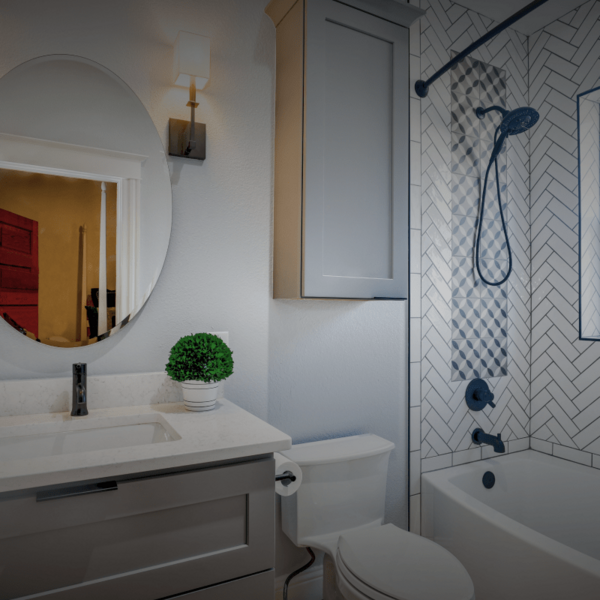Ah, the eternal question. It’s right up there with “To be or not to be,” or “Should I stay or should I go?” Okay, maybe not, but it IS one of the first decisions to make when embarking upon the Tiny House life.
Whether or not to choose a Tiny House on wheels or a stationary Tiny House on foundation is as likely to be a matter of personal circumstances as it is personal preference. If you have long-term access to a piece of property, then you have the choice of either option. Otherwise, you’re probably looking at a Tiny House on wheels.
Assume for the sake of this discussion that you do have a choice between two options. Let’s take a look at some of the factors that can come into play when making your decision.


Flexibility
Moving
Changing locations is easier if you don’t have to sell your home and buy a new one. Among the many reasons for moving are:
- Relocating for a change of job
- Moving to be closer to a family member
- Changing locations for a relationship
- You’re ready for a change of scenery
The Nomad Lifestyle
Continuous travel is another possibility. With a Tiny House on wheels, you can see the country while literally bringing the comforts of home with you.
Change in Current Location Circumstances
Things change. With a stationary Tiny House, you may be stuck either living with what happens around you or moving out of your home. With a Tiny House on wheels, there’s no need to sell. Here are some potential situations that might cause you to hitch up a Tiny House on wheels and find a new place to park:
- Disruptive or unpleasant neighbors move in
- A construction crew shows up to build a high rise next door
- School district boundaries change
- Your neighborhood degrades or gentrifies
- The zoning in your area changes
Changes in Family Dynamics
People also change. A Tiny House on wheels can provide flexibility by acting as temporary or permanent extra housing for the people in your life. Even if you’re not a Tiny Home dweller, you can add a Tiny House to your property for these situations:
- Keeping aging relatives close to you
- Providing housing for grown kids who are commuting to college or newly graduated
- Furnishing space for teens who want some extra independence
- The traditional “Mother-in-Law” housing situation
These purposes can be fulfilled by a stationary Tiny House as well, but depending on how well you get along with your Mother in Law, wheels might be the wiser move (rimshot).
Size and Shape
Does my Tiny House on wheels have to be a box?
A Tiny House on wheels has to fit on its trailer “foundation.” Unless you want to deal with oversized load permits, stick to highway-legal standards. This usually means:
- Rectangular footprint
- Up to 8.5 feet wide
- Up to 40 feet long (or more)
- Up to 13.5 feet tall
Despite these limitations, there’s an impressive range of creativity being displayed in the Tiny House world for Tiny Houses on wheels.

What Shape Should a Stationary Tiny House Be?
With a stationary Tiny House, you have so much more freedom as to the size and shape of your Tiny Home. “Tiny” is generally considered 500 square feet or less. But within that debatable parameter you have an immense range of possibilities for shaping your space. Try one of these ideas on for size, and shape your stationary Tiny House to your heart’s content:
- A diminutive Thoreauvian log cabin
- A miniscule modernist house of glass
- A petite Pyramid of Giza
- An undersized classical Greek Parthenon
- A miniature Frank Gehry blob
- A tiny lookout tower
- Your own personal Hobbit hole
- A teeny Gothic cathedral complete with tiny flying buttresses

Weight Distribution
A Tiny House on wheels requires attention to weight distribution. Heavier components must be placed in relation to a trailer’s tongue and axles. A stationary Tiny House isn’t restricted in this way.
Going Up or Down
There’s no 13.5-foot limit in height for a stationary Tiny House. Plus you have the option of basements, crawlspaces, or root cellars.
Materials
Along with a wider range of options for size and shape, a stationary Tiny House allows you more freedom with materials.

Weight
A Tiny House on wheels has a set weight limit dictated by its trailer base. Heavier construction materials may not be viable. For a stationary Tiny House, on the other hand, the weight of your construction materials is not an issue.
Fragility
Much stress is put on a Tiny House on wheels when it is traveling down the highway. Fragile materials can crack or fail in transit. This is obviously not an issue for stationary Tiny Homes.
Some examples of materials that make more sense for stationary Tiny Houses than for Tiny Houses on wheels include:
- Concrete
- Brick and other masonry
- Natural plaster finishes
- Copper plumbing components
- Cob, adobe, and other earthen construction materials
- Large expanses of glass
Location Options
Where can I park my Tiny House on Wheels?
A Tiny House on wheels allows you to sample as many changes of scenery as you desire. But it is limited to relatively flat, stable places to park. And it requires decent road access to the parking spot.
Where can I build my stationary Tiny House?
A stationary Tiny House can be built in many places that a Tiny House on wheels cannot access or comfortably park on.
Keep in mind that the natural frost line in your location of choice will play a role in the type of foundation you choose for a stationary Tiny House.
Thanks to pier foundations and pilings, stationary Tiny Houses can be built on:
- Steep slopes
- Areas prone to flooding
- Sandy beaches
- waterlogged land

Gale forces
Batten down or evacuate?
Hurricane tie-downs can help stabilize a Tiny House on wheels in high-wind environments.
A stationary Tiny House is rooted more firmly to the ground. And it can be shaped to shelter from prevailing winds.
Conversely, in the event of a natural disaster, you can evacuate your entire house if you have a Tiny House on wheels and enough forewarning.

Zoning and Legal Concerns
How do zoning and legal designations affect my choice?
- A stationary Tiny House may have to adhere to local minimum size restrictions for permanent residential structures. This might be more than what’s generally considered “Tiny.”
- A Tiny House on wheels is usually legally designated an RV. In some areas there are restrictions against living in an RV full-time.
- Tiny Houses on wheels are less likely to fully comply with existing building codes than are permanent Tiny Houses on foundations.
Utilities
What Utility Options are Available for Stationary Tiny Houses vs. Tiny Homes on Wheels?
The systems onboard a Tiny House on wheels are usually akin to those on an RV or boat:
- Compost or RV or marine toilet
- RV water connection, often via hose
- Drainage to greywater system or tank
- 30 amp electrical cord plugged into an outlet on-site
The stationary Tiny House need not be limited to these options. It can adopt the same systems used on a mobile Tiny House, or it can opt for any of these:
- A traditional flush toilet that empties to a septic system or city sewer
- Greywater drainage to septic or sewer
- Permanent connection to the local electrical grid
- Heating system components that aren’t mobile-friendly, such as a geothermal heat pump or boiler
Theft
A concern for mobile Tiny Houses?
Theft is unfortunately a potential concern for the owner of a Tiny House on wheels. It’s a situation that stationary Tiny House owners do not have to worry about.
The following precautions can greatly reduce the risk of your Tiny Home being stolen (or increase its likelihood of timely recovery):
- Coupler locks
- Wheel locks
- Hidden GPS location devices (oftentimes paired with an app on your phone)

Grounding/Earthing
What is Earthing?
Although considered somewhat controversial, the concept of earthing (or grounding) is gaining wider acceptance. Its premise is that being in contact with the earth is highly beneficial to our health by reducing inflammation through direct contact with the slightly negative electromagnetic charge of the earth.
How do I do it?
There are several ways to ground yourself naturally:
-
Walking barefoot on the ground, in places such as:
- Sandy beaches
- Grass
- Dirt trails
- Rocky shores
- Concrete (but not asphalt)
-
Wearing conductive footwear (leather soles or special ’earthing’ shoes)
-
Sitting or lying on the bare ground (preferably with some skin in contact with the earth)
How do I implement it in my Tiny House?
To take full advantage of grounding, implement it in your home environment.
For a Tiny House on wheels:
- Use a grounding mat at your computer desk that plugs into a grounded outlet. This helps protect you from the negative effects of electromagnetic frequencies from your electronics.
- Use grounding sheets or mats on your bed (they plug into an outlet like the grounding mat). Many people report better sleep with the use of these tools.
For a Stationary Tiny House:
- In a stationary Tiny House you have the option of the ultimate earthing tool: a concrete slab foundation. Every square inch of your ground level floor puts you in direct contact with the earth’s beneficial electromagnetic frequencies. (Just don’t cover it with nonconductive materials such as wood).
- You also have the same tools available as can be used in a Tiny House on wheels.
For more on the benefits of Earthing, check out this video:
DOWN TO EARTH from Big Picture Ranch on Vimeo.
Feeling of Home
For some people, living in a Tiny House on wheels might not feel enough like a “real” house. These reasons might lead you to choose a stationary Tiny Home instead:
- There can occasionally be a slight sense of wobbliness to a Tiny on wheels, especially in areas with high winds.
- The space below a Tiny House on wheels is open. Therefore floors can be a bit chilly in cold climates. Skirting around the trailer frame can make a difference. And the addition of floor rugs and ample floor insulation can abate this issue.
Best or Worst of Both Worlds?
Can a Stationary Tiny House be Mobile?
Maybe you prefer the idea of a stationary Tiny Home, but still want the ability to take it with you if you move.
You can build a fixed structure in ways that allow it to be lifted onto a truck and hauled to a new location.
It’s wise to choose a rectangle shape typical of a Tiny House on wheels. That way it will fit on a towing truck that’s road-legal without special hauling permits. Even if you opt for an oversize footprint, there are limits to what a truck can haul.

Floating Home

Image source: trendir.com
The life aquatic?
Yet another possibility is the Tiny House on a floating platform.
Stationary:
A floating Tiny House could be considered stationary if permanently moored to pilings in a particular location.
Mobile:
A floating Tiny House could also have the means, such as an outboard motor, of propelling itself through the body of water in which it is located.
Land lubber:
Or a floating Tiny House could be lifted out of the water and onto a waiting truck to be hauled to a new location: another body of water… or a foundation situated on land… or it could even be attached to a trailer in order to become a Tiny House on wheels.
Makes you think about converting one of those amphibious buses into a Tiny Home, doesn’t it?!

